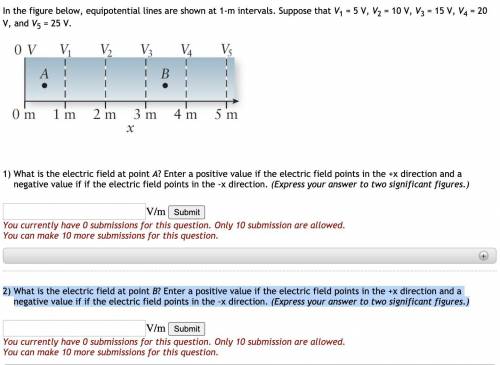
Physics, 30.06.2021 02:30 sierranowe2003
In the figure below, equipotential lines are shown at 1-m intervals. Suppose that V1 = 5 V, V2 = 10 V, V3 = 15 V, V4 = 20 V, and V5 = 25 V. 1) What is the electric field at point A? Enter a positive value if the electric field points in the +x direction and a negative value if the electric field points in the -x direction. (Express your answer to two significant figures.) 2) What is the electric field at point B? Enter a positive value if the electric field points in the +x direction and a negative value if the electric field points in the -x direction. (Express your answer to two significant figures.)


Answers: 2
Another question on Physics

Physics, 21.06.2019 23:30
Part a determine the magnitude of the x component of f using scalar notation. fx f x = nothing lb request answer part b determine the magnitude of the y component of f using scalar notation. fy f y = nothing lb request answer part c determine the magnitude of the z component of f using scalar notation. fz f z = nothing lb request answer provide feedback figure1 of 1a force vector acting on a ring attached to the ground is shown in the xyz space together with its x, y, and z components lying on the corresponding positive axes. the ring is located at the origin. force f is located in the first octant. f makes an angle of 60 degrees with its x component and an angle of 45 degrees with its y component. a force vector acting on a ring attached to the ground is shown in the xyz space together with its x, y, and z components lying on the corresponding positive axes. the ring is located at the origin. force f is located in the first octant. f makes an angle of 60 degrees with its x component and an angle of 45 degrees with its y component.
Answers: 2

Physics, 22.06.2019 05:00
Red light strikes a metal surface and electrons are ejected. if violet light is now used with a 10% greater intensity, what will happen to the ejection rate (number of ejected electrons per second) and the maximum energy of the electrons? a) greater ejection rate; same maximum energyb) same ejection rate; greater maximum energyc) greater ejection rate; greater maximum energyd) same ejection rate; same maximum energye) none of the above answers are correct
Answers: 1

Physics, 22.06.2019 13:30
The two stars in a certain binary star system move in circular orbits. the first star, alpha, has an orbital speed of 36 km/s. the second star, beta, has an orbital speed of 12 km/s. the orbital period is 137 d. a) what is the mass of the star alpha? b) what is the mass of the star beta?
Answers: 1

Physics, 22.06.2019 15:00
A10 kg box initially at rest is pulled 18 meters across a horizontal, frictionless surface by a 40 n force. what is the block’s final velocity over the 18 meters?
Answers: 2
You know the right answer?
In the figure below, equipotential lines are shown at 1-m intervals. Suppose that V1 = 5 V, V2 = 10...
Questions

Mathematics, 02.12.2020 21:10



Computers and Technology, 02.12.2020 21:10

Spanish, 02.12.2020 21:10


Arts, 02.12.2020 21:10


English, 02.12.2020 21:10


Physics, 02.12.2020 21:10

Spanish, 02.12.2020 21:10


Chemistry, 02.12.2020 21:10

English, 02.12.2020 21:10

Social Studies, 02.12.2020 21:10



History, 02.12.2020 21:10

Mathematics, 02.12.2020 21:10



